Dell U2412M - 16:10 IPS without Breaking the Bank
by Chris Heinonen on February 28, 2012 9:00 AM ESTDell U2412M Color Quality
With that long write-up out of the way, you might expect that there was something in particular to the U2412M that led me to explain our testing and results. There initially was but it actually proved to be a software issue; still, I thought the explanation on the previous page would be useful for everyone. For our uncalibrated measurements, I used the profile included on the CD, set the brightness to 200 nits, and then measured using the i1Pro meter.
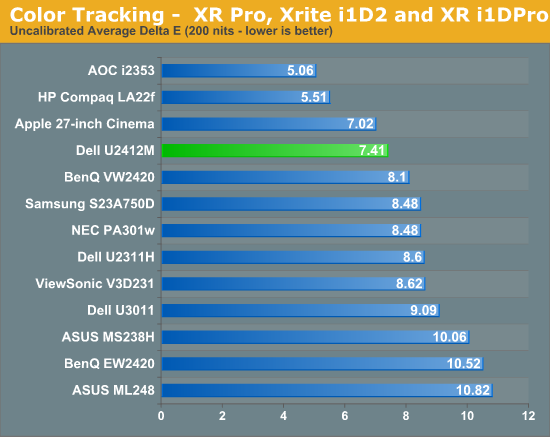
Here we see a score over 7, which is about what we expect to see on a monitor straight out of the box. Comparing this to previous displays isn’t easy to do as most of those used the i1Display2, which isn’t nearly as accurate as the i1Pro is. Of course, all displays do better once calibrated, so I kept the brightness target at 200 nits, with a white point target of D65, gamma of 2.2, and minimum black target.
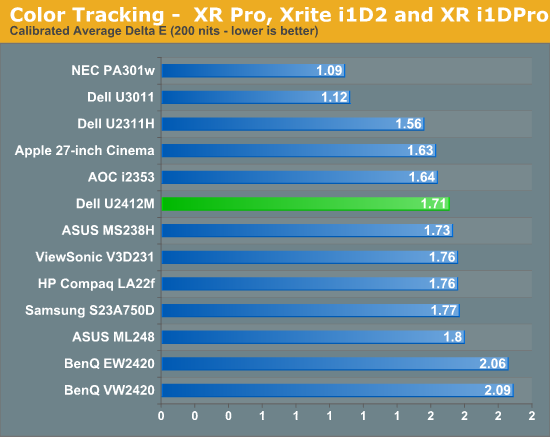
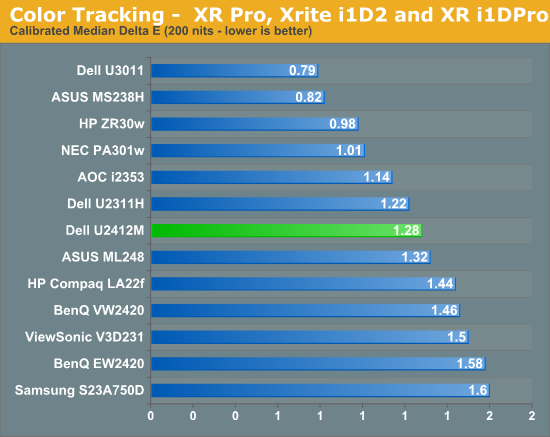
The errors for the Dell look very similar to what we have seen on other monitors. The color gamut is not AdobeRGB, so some of the patches are outside of the range for the display and can’t be rendered correctly. This leads to the spikes in the chart for blue samples and the higher average dE. We included the median dE number so you can see that the value drops quite a bit if we look at that. Everything other than blue is pretty good, and the grayscale is right around 1. So this is nice overall, though not perfectly accurate due to the color gamut and possibly due to the 6-bit panel. Now we will profile again to see if the results are similar with a target of 100 nits instead of 200 nits.
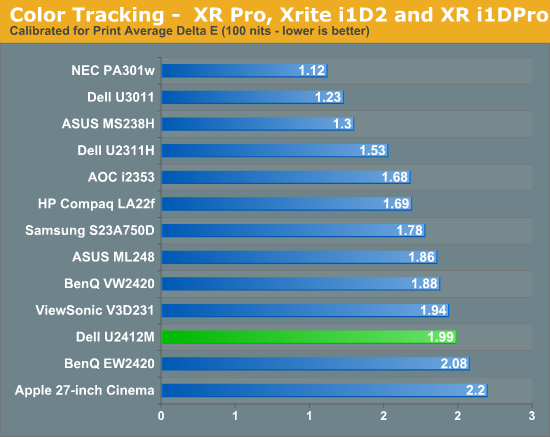
The error seems to rise a bit here, most notably in the grayscale that you would want to keep very neutral for print work. Most colors stay below 3.0 in their error (which is considered the threshold of being visible to the naked eye in motion) but again the blues are past that and errors would be visible to someone that was looking. For serious print work, you probably need to look for something that can use the full AdobeRGB gamut.



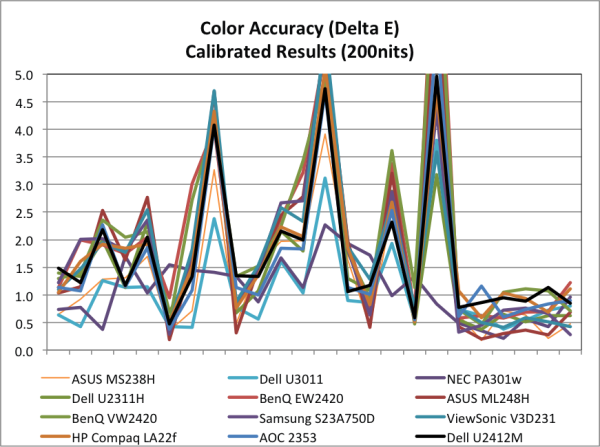
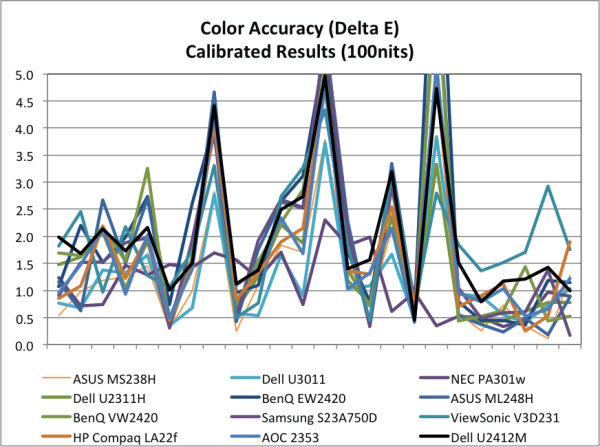








143 Comments
View All Comments
Braumin - Tuesday, February 28, 2012 - link
I bought this when it first came out. I had been looking at an IPS monitor to replace my aging S-PVA monitor. I really hate TN.The price is just amazing on this, and the quality is top notch.
No, it doesn't have everything that everyone needs, but it has exactly what I needed.
Great review!
Oxford Guy - Tuesday, February 28, 2012 - link
What's wrong with the monitor you have? Is the backlight becoming too weak or what?Braumin - Wednesday, February 29, 2012 - link
19" 1280x1024 was good when I got it, but really not enough desktop space. I much prefer the widescreen for gaming and such.TegiriNenashi - Tuesday, February 28, 2012 - link
The statement that 16:9 panels were introduced at lower prices is false. I clearly remeber that the "latest and greatest" "Full HD" were rarity and commanded a premium, compared to "boring" 1920x1200 panels, which could be found anywhere from $200 and up.JarredWalton - Tuesday, February 28, 2012 - link
I'm sorry, but I'll have to disagree. I don't know that I've ever seen a new 24" 1920x1200 display for under $250, period. Not even the cheap, TN, low quality displays with now height adjustment have gotten that low. But 1080p, while perhaps there were a few more expensive models initially, rapidly dropped into the <$250 range for 23-24" models, and now they start at around $170 (compared to $270 for the cheapest 1920x1200 LCD).Zoomer - Tuesday, February 28, 2012 - link
Remember back in Sept when some idiot mentioned HP was divesting it's PC division? The ZR24w dropped to $250 after rebate then.And the vw266 was under $250 for some time. Not technically 24", but I figure being bigger shouldn't count against it.
kmmatney - Tuesday, February 28, 2012 - link
Those are rare exceptions, but for the most part 1920 x 1200 monitors were always pretty expensive, and it wasn't until the 1080p monitors came out that prices started to really drop. My Soyo 24" MVA panel was a bargain at $299 when it came out, and after these sold out there wasn't anything near that price for 2 years in terms of price and quality.papapapapapapapababy - Tuesday, February 28, 2012 - link
stoper reading at led backlight, ill stick with my u2711... led backligth makes me sick( literally)
Death666Angel - Tuesday, February 28, 2012 - link
Not sure why you would want to change to a 24" model from a 27" inch one, but I'll bite:The PWM for brightness makes you sick, not the LED technology itself. The HP ZR2740w has no PWM and regulates brightness continually. See for example: http://www.prad.de/new/monitore/test/2012/test-hp-...
Oxford Guy - Tuesday, February 28, 2012 - link
Every LCD monitor review should measure flicker.I really want to get a constant control backlight, but I like my A-MVA panel's high contrast ratio.
If review sites put pressure on manufacturers by highlighting this problem, then maybe we'll see less PWM flicker.